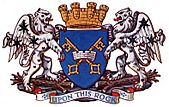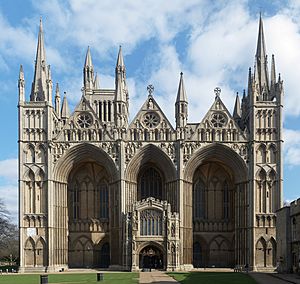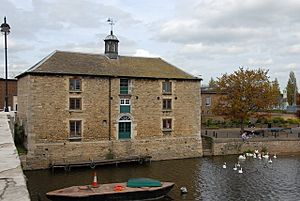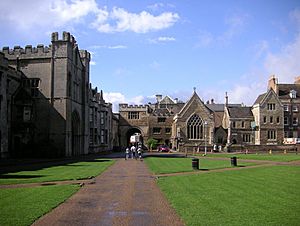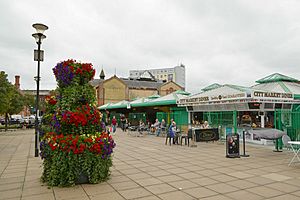Peterborough facts for kids
Quick facts for kids
Peterborough
|
||
|---|---|---|
|
City and unitary authority
|
||
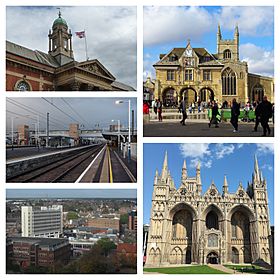
Clockwise from top left: the town hall, the Cathedral Square and the guildhall, cathedral, city skyline and railway station
|
||
|
||
| Motto(s):
Upon this rock I will build my church
|
||

Peterborough Unitary Authority Area shown within Cambridgeshire
|
||
| Sovereign state | United Kingdom | |
| Country | England | |
| Region | East of England | |
| Ceremonial county | Cambridgeshire | |
| Historic County | Northamptonshire | |
| Admin HQ | Peterborough | |
| City status | 1541 | |
| Incorporated | 1874 | |
| Unitary | 1998 | |
| Government | ||
| • Type | Unitary authority | |
| Area | ||
| • Total | 132.58 sq mi (343.38 km2) | |
| Population
(2005 est.)
|
||
| • Total | 202,259 | |
| • Ethnicity | 82.5% White 11.7% Asian 2.3% Black 0.8% Other 2.8% Mixed |
|
| Time zone | UTC±0 (GMT) | |
| • Summer (DST) | UTC+1 (BST) | |
| Postcode area |
PE
|
|
| Area code(s) | 01733 | |
| Vehicle registration area code | AA, AB, AC, AD, AE, AF, AG, AJ, AK, AM, AN | |
| ISO 3166-2 | GB-PTE | |
| ONS code | 00JA (ONS) E06000031 (GSS) |
|
| OS grid reference | TL185998 | |
| NUTS 3 | UKH11 | |
| Website | www.peterborough.gov.uk | |
Peterborough is a cathedral city and unitary authority area in Cambridgeshire, England, with a population of 202,110 in 2017. Originally part of Northamptonshire, it became part of Cambridgeshire from 1974. The city is 76 mi (122 km) north of London, on the River Nene which flows into the North Sea 30 mi (48 km) to the north-east. The railway station is an important stop on the East Coast Main Line between London and Edinburgh.
The local topography is flat, and in some places the land lies below sea level, for example in parts of the Fens to the east of Peterborough. Human settlement in the area began before the Bronze Age, as can be seen at the Flag Fen archaeological site to the east of the current city centre, also with evidence of Roman occupation. The Anglo-Saxon period saw the establishment of a monastery, Medeshamstede, which later became Peterborough Cathedral.
The population grew rapidly after the railways arrived in the 19th century, and Peterborough became an industrial centre, particularly known for its brick manufacture. After the Second World War, growth was limited until designation as a New Town in the 1960s. Housing and population are expanding and a £1-billion regeneration of the city centre and immediately surrounding area is under way. Industrial employment has fallen since then, a significant proportion of new jobs being in financial services and distribution.
Contents
History
- Etymology
The town's name changed to Burgh from the late tenth century, possibly after Abbot Kenulf had built a defensive wall around the abbey, and eventually developed into the form Peterborough; the town does not appear to have been a borough until the 12th century. The contrasting form Gildenburgh is also found in the 12th century history of the abbey, the Peterborough version of the Anglo-Saxon Chronicle (see Peterborough Chronicle below) and in a history of the abbey by the monk Hugh Candidus.
Early history
Present-day Peterborough is the latest in a series of settlements which have at one time or other benefited from its site where the Nene leaves large areas of permanently drained land for the fens. Remains of Bronze Age settlement and what is thought to be religious activity can be seen at the Flag Fen archaeological site to the east of the city centre. The Romans established a fortified garrison town at Durobrivae on Ermine Street, five miles (8 km) to the west in Water Newton, around the middle of the 1st century AD. Durobrivae's earliest appearance among surviving records is in the Antonine Itinerary of the late 2nd century. There was also a large 1st century Roman fort at Longthorpe, designed to house half a legion, or about 3,000 soldiers; it may have been established as early as around AD 44–48. Peterborough was an important area of ceramic production in the Roman period, providing Nene Valley Ware that was traded as far away as Cornwall and the Antonine Wall, Caledonia.
Peterborough is shown by its original name Medeshamstede to have possibly been an Anglian settlement before AD 655, when Saxwulf founded a monastery on land granted to him for that purpose by Peada of Mercia, who converted to Christianity and was briefly ruler of the smaller Middle Angles sub-group. His brother Wulfhere murdered his own sons, similarly converted and then finished the monastery by way of atonement.
Hereward, the outlaw, wake or exile, set off with supporters from his exile in Flanders and rampaged through the town in 1069 or 1070. Outraged, Abbot Turold erected a fort or castle, which, from his name, was called Mont Turold: this mound, or hill, is on the outside of the deanery garden, now called Tout Hill, although in 1848 Tot-hill or Toot Hill. The abbey church was rebuilt and greatly enlarged in the 12th century. The Peterborough Chronicle, a version of the Anglo-Saxon one, contains unique information about the history of England after the Norman conquest, written here by monks in the 12th century. This is the only known prose history in English between the conquest and the later 14th century. The burgesses received their first charter from "Abbot Robert" – probably Robert of Sutton (1262–1273). The place suffered materially in the war between John I and the confederate barons, many of whom took refuge in the monastery here and in Crowland Abbey, from which sanctuaries they were forced by the king's soldiers, who plundered the religious houses and carried off great treasures. The abbey church became one of Henry VIII's retained, more secular, cathedrals in 1541, having been assessed at the Dissolution (in the King's Books) as having revenue at £1,972.7.¾ per annum.
When civil war broke out, Peterborough was divided between supporters of King Charles I (Cavaliers) and supporters of the Long Parliament (Roundheads). The city lay on the border of the Eastern Association of counties which sided with Parliament, and the war reached Peterborough in 1643 when soldiers arrived in the city to attack Royalist strongholds at Stamford and Crowland. The Royalist forces were defeated within a few weeks and retreated to Burghley House, where they were captured and sent to Cambridge. While the Parliamentary soldiers were in Peterborough, however, they ransacked the cathedral, destroying the Lady Chapel, chapter house, cloister, high altar and choir stalls, as well as mediaeval decoration and records.
Housing and sanitary improvements were effected under the provisions of an Act of Parliament passed in 1790 and an act to build a gaol to replace the two that previously stood, was passed in 1839. After the dissolution the dean and chapter, who succeeded the abbot as lords of the manor, appointed a high bailiff and the constables and other borough officers were elected at their court leet; but this ended when the municipal borough was incorporated in 1874 under the government of a mayor, six aldermen and eighteen councillors. Among the privileges claimed by the abbot as early as the 13th century was that of having a prison for felons taken in the Soke of Peterborough. In 1576 Bishop Edmund Scambler sold the lordship of the hundred of Nassaburgh, which was coextensive with the Soke, to Queen Elizabeth I, who gave it to Lord Burghley, and from that time until the 19th century he and his descendants, the Earls and Marquesses of Exeter, had a separate gaol for prisoners arrested in the Soke. The abbot formerly held four fairs, of which two, St. Peter's Fair, granted in 1189 and later held on the second Tuesday and Wednesday in July, and the Brigge Fair, granted in 1439 and later held on the first Tuesday, Wednesday and Thursday in October, were purchased by the corporation from the Ecclesiastical Commissioners in 1876. The Bridge Fair, as it is now known, granted to the abbey by King Henry VI, survives. Prayers for the opening of the fair were once said at the morning service in the cathedral, followed by a civic proclamation and a sausage lunch at the town hall which still takes place. The mayor traditionally leads a procession from the town hall to the fair where the proclamation is read, asking all persons to "behave soberly and civilly, and to pay their just dues and demands according to the laws of the realm and the rights of the City of Peterborough".
Modern history
Railway lines began operating locally during the 1840s, but it was the 1850 opening of the Great Northern Railway's line from London to York that transformed Peterborough from a market town to an industrial centre. Lord Exeter had opposed the railway passing through Stamford, so Peterborough, situated between two main terminals at London and Doncaster, increasingly developed as a regional hub.
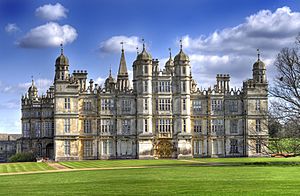
Coupled with vast local clay deposits, the railway enabled large-scale brick-making and distribution to take place. The area was the UK's leading producer of bricks for much of the twentieth century. Brick-making had been a small seasonal craft since the early nineteenth century, but during the 1890s successful experiments at Fletton using the harder clays from a lower level had resulted in a much more efficient process. The market dominance during this period of the London Brick Company, founded by the prolific Scottish builder and architect John Cathles Hill, gave rise to some of the country's most well-known landmarks, all built using the ubiquitous Fletton Brick. Perkins Engines was established in Peterborough in 1932 by Frank Perkins, creator of the Perkins diesel engine. Thirty years later it employed more than a tenth of the population of Peterborough, mainly at Eastfield. Baker Perkins had relocated from London to Westwood, now the site of HM Prison Peterborough, in 1903, followed by Peter Brotherhood to Walton in 1906; both manufacturers of industrial machinery, they too became major employers in the city. British Sugar remains headquartered in Woodston, although the beet sugar factory, which opened there in 1926, was closed in 1991.
Founded at the Corn Exchange in 1860, Norwich and Peterborough (N&P) was the ninth largest building society at the time of its merger into the Yorkshire Group in 2011. N&P continues to operate under its own brand administered at Lynch Wood. Until it merged with the Midlands Co-op in 2013, Anglia Regional, the UK's fifth largest co-operative society, was also based in Peterborough, where it was established in 1876. The combined society began trading as Central England Co-operative in 2014.
Designated a New Town in 1967, Peterborough Development Corporation was formed in partnership with the city and county councils to house London's overspill population in new townships sited around the existing urban area. There were to be four townships, one each at Bretton (originally to be called Milton, a hamlet in the Middle Ages), Orton, Paston/ Werrington and Castor. The last of these was never built, but a fourth, called Hampton, is now taking shape south of the city. It was decided that the city should have a major indoor shopping centre at its heart. Planning permission was received in late summer 1976 and Queensgate, containing over 90 stores and including parking for 2,300 cars, was opened by Queen Beatrix of the Netherlands in 1982. 34 miles (55 km) of urban roads were planned and a network of high-speed landscaped thoroughfares, known as parkways, was constructed.
Peterborough's population grew by 45.4% between 1971 and 1991. New service-sector companies like Thomas Cook and Pearl Assurance were attracted to the city, ending the dominance of the manufacturing industry as employers. An urban regeneration company named Opportunity Peterborough, under the chairmanship of Lord Mawhinney, was set up by the Office of the Deputy Prime Minister in 2005 to oversee Peterborough's future development. Between 2006 and 2012 a £1 billion redevelopment of the city centre and surrounding areas was planned. The master plan provides guidelines on the physical shaping of the city centre over the next 15–20 years. Proposals are still progressing for the north of Westgate, the south bank and the station quarter, where Network Rail is preparing a major mixed use development. Whilst recognising that the reconfiguration of the relationship between the city and station was critical, English Heritage found the current plans for Westgate unconvincing and felt more thought should be given to the vitality of the historic core.
With the city expanding, in July 2005 the council adopted a new statutory development plan. Its aim is to accommodate an additional 22,000 homes, 18,000 jobs and over 40,000 people living in Peterborough by 2020. The newly developing Hampton township will be completed, there will be a 1,500-home development at Stanground and a further 1,200-home development at Paston.
Transport
Rail
Peterborough railway station is a principal stop on the East Coast Main Line, 45–50 minutes' journey time from central London, with high-speed intercity services from King's Cross to Edinburgh Waverley operated by the London North Eastern Railway at around a 20-minute frequency, and slower commuter services terminating at Peterborough operated by Govia Thameslink Railway. It is a major railway junction where a number of cross-country routes converge. East Midlands Railway operates the Peterborough to Lincoln Line and a route from Norwich to Liverpool Lime Street via the main line north of Peterborough, CrossCountry operates the Birmingham to Peterborough Line through to Cambridge and Stansted Airport while Greater Anglia operates the Ely to Peterborough Line with a service to Ipswich. Peterborough has a business airport with a paved runway at Holme and a recreational airfield hosting a parachute school at Sibson.
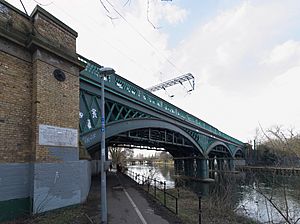
Water
The River Nene, made navigable from the port at Wisbech to Northampton by 1761, passes through the city centre. The Nene Viaduct carries the railway over the river. It was built in 1847 by Sir William and Joseph Cubitt. William Cubitt was the chief engineer of Crystal Palace erected at Hyde Park in 1851. Apart from some minor repairs in 1910 and 1914 (the steel bands and cross braces around the fluted legs) the bridge remains as Cubitts built it. Now a Grade II* listed structure, it is the oldest surviving cast iron railway bridge in the UK. By the Town Bridge, the Customs House, built in the early eighteenth century, is a visible reminder of the city's past function as an inland port. The Environment Agency navigation starts at the junction with the Northampton arm of the Grand Union Canal and extends for 91 miles (147 km) ending at Bevis Hall just upstream of Wisbech. The tidal limit used to be Woodston Wharf until the Dog-in-a-Doublet lock was built five miles (8 km) downstream in 1937.
Road
The A1/A1(M) primary route (part of European route E15) broadly follows the path of the historic Great North Road from St Paul's Cathedral in the heart of London, through Peterborough (Junction 17), continuing north a further 335 miles (539 km) to central Edinburgh. In 1899 the British Electric Traction Company sought permission for a tramway joining the northern suburbs with the city centre. The system, which operated under the name Peterborough Electric Traction Company, opened in 1903 and was abandoned in favour of motor buses in 1930, when it was merged into the Eastern Counties Omnibus Company. Today, bus services in the city are operated by several companies including Stagecoach (formerly Cambus and Viscount) and Delaine Buses. Despite its large-scale growth, Peterborough has the fastest peak and off-peak travel times for a city of its size in the UK, due to the construction of the parkways. The Local Transport Plan anticipated expenditure totalling around £180 million for the period up to 2010 on major road schemes to accommodate development.
The combination of rail connections to the Port of Felixstowe and to the East Coast Main Line as well as a road connection via the A1(M) has led to Peterborough being proposed as the site of a 334 acres (1.35 km2) rail-road logistics and distribution centre to be known as Magna Park.
Green Wheel and City Cycling
The Peterborough Millennium Green Wheel is a 50-mile (80 km) network of cycleways, footpaths and bridleways which provide safe, continuous routes around the city with radiating spokes connecting to the city centre. The project has also created a sculpture trail, which provides functional, landscape artworks along the Green Wheel route and a Living Landmarks project involving the local community in the creation of local landscape features such as mini woodlands, ponds and hedgerows. Another long-distance footpath, the Hereward Way, runs from Oakham in Rutland, through Peterborough, to East Harling in Norfolk. While cycling within the city received a boost during the COVID-19 pandemic with the introduction of new cycle lanes in busy streets, plans to connect the villages West of Peterborough with a new cycle track have been refused permission and some cycle lane decisions have been reversed in the city centre during easing of the corona virus lockdowns.
Demography
Population
Peterborough has a population of 202,259 (2005 est.). It is forecast to reach 200,000 in 2018–9 and 220,000 by around 2031.
| Year | City | Soke | Redistricted |
|---|---|---|---|
| 1901 | 30,872 | 41,122 | 46,986 |
| 1911 | 33,574 | 44,718 | 53,114 |
| 1921 | 35,532 | 46,959 | 58,186 |
| 1931 | 43,551 | 51,839 | 63,745 |
| 1939 | 49,248 | 58,303 | 69,855 |
| 1951 | 53,417 | 63,791 | 76,555 |
| 1961 | 62,340 | 74,758 | 89,794 |
| 1971 | 69,556 | 85,820 | 105,323 |
| 1981 | 131,696 | ||
| 1991 | 155,050 | ||
| 2001 | 156,060 | ||
| 2011 | 183,600 (+ 16.6%) | ||
Peterborough's population growth was reportedly the second fastest of any British city over the ten years from 2004 to 2013, driven partly by immigration.
Ethnicity
According to the 2011 Census, 82.5% of Peterborough's residents categorised themselves as white, 2.8% of mixed ethnic groups, 11.7% Asian, 2.3 per cent black and 0.8% other. Amongst the white population, the largest categories were indigenous groups, those being English/Welsh/Scottish/Northern Irish/British (70.9%), and other white (10.6%). Those of Pakistani ethnicity accounted for 6.6% of the population and those of Indian ethnicity 2.5.%. The largest black group were those of African ethnicity (1.4%).
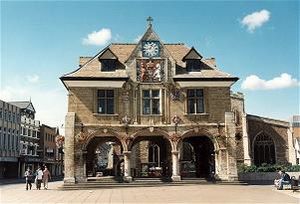
Peterborough is home to one of the largest concentrations of Italian immigrants in the UK. This is mainly as a result of labour recruitment in the 1950s by the London Brick Company in the southern Italian regions of Apulia and Campania. By 1960, approximately 3,000 Italian men were employed by London Brick, mostly at the Fletton works. In 1962, the Scalabrini Fathers, who first arrived in 1956, purchased an old school and converted it into a mission church named after the patron saint of workers Saint Joseph (San Giuseppe). By 1991, over 3,000 christenings of second-generation Italians had been carried out there. In 1996, it was estimated that the Italian community of Peterborough numbered 7,000, making it the third largest in the UK after London and Bedford. The 2011 Census recorded 1,179 residents born in Italy.
In the late twentieth century the main source of immigration was from new Commonwealth countries. The 2011 Census showed that a total of 24,166 migrants moved to Peterborough between 2001 and 2011. The city has experienced significant immigration from the A8 countries that joined the European Union in 2004, and in 2011, 14,134 residents of the city were people born in Central and Eastern Europe.
The number of languages in use is growing where previously few languages other than English were spoken. As of 2006[update], Peterborough offered classes in Italian, Urdu and Punjabi in its primary schools.
Religion
Christianity has the largest following in Peterborough, in particular the Church of England, with a significant number of parish churches and a cathedral. 56.7% of Peterborough's residents classified themselves as Christian in the 2011 Census. Recent immigration to the city has also seen the Roman Catholic population increase substantially. Other denominations are also in evidence; the latest church to be constructed is a £7 million "superchurch," KingsGate, formerly Peterborough Community Church, which can seat up to 1,800 worshippers. In comparison with the rest of England, Peterborough has a lower proportion of Christians, Buddhists, Hindus, Jews and Sikhs. The city has a higher percentage of Muslims than England as a whole (9.4% compared to 5% nationally). The majority of Muslims reside in the Millfield, West Town and New England areas of the city, where two large mosques (including the Faidhan-e-Madina Mosque and Husaini Islamic Center-Peterborough) are based. Peterborough also has both Hindu (Bharat Hindu Samaj) and Sikh (Singh Sabha Gurdwara) temples in these areas.
The Anglican Diocese of Peterborough covers roughly 1,200 square miles (3,100 km2), including the whole of Northamptonshire, Rutland and the Soke of Peterborough. The parts of the city that lie south of the river, which were historically in Huntingdonshire, fall within the Diocese of Ely, which covers the remainder of Cambridgeshire and western Norfolk. The current Bishop of Peterborough has been appointed Assistant Bishop in the Diocese of Ely, with pastoral care for these parishes delegated to him by the Bishop of Ely. The city falls wholly within the Roman Catholic Diocese of East Anglia (which has its seat at the Cathedral Church of Saint John the Baptist, Norwich) and is served by Saint Peter and All Souls Church, built in 1896 and decorated in the Gothic style. The Greek Orthodox Community of Saint Cyril, Patriarch of Jerusalem was established in 1991 under the Orthodox Archdiocese of Thyateira and Great Britain.
Culture
Education
Peterborough has one independent boarding school: The Peterborough School at Westwood House, founded in 1895. The school caters for girls and now boys up to the age of 18. Peterborough's state schools have recently undergone immense change. Five of the city's 15 secondary schools were closed in July 2007, to be demolished over the coming years. John Mansfield (now an adult learning centre), Hereward (formerly Eastholm, now City of Peterborough Academy, sponsored by the Greenwood Dale Foundation Trust) and Deacon's were replaced with the flagship Thomas Deacon Academy, designed by Lord Foster of Thames Bank which opened in September 2007.
The Voyager School, which has specialist media arts status, replaced Bretton Woods and Walton comprehensive. The schools that remain have been extended and enlarged. Over £200 million was spent and the changes on-going to 2010. The King's School is one of seven schools established, or in some cases re-endowed and renamed, by King Henry VIII during the Dissolution of the Monasteries to pray for his soul. In 2006, 39.4% of Peterborough local education authority pupils attained five grades A* to C, including English and Mathematics, in the General Certificate of Secondary Education, lower than the national average of 45.8%.
The city has two colleges of further and higher education, Peterborough Regional College (established in 1946 as Peterborough Technical College) and City College Peterborough (known as Peterborough College of Adult Education until 2010). As of 2004[update], Peterborough Regional College attracts over 15,000 students each year from the UK and abroad and is ranked in the top five per cent of colleges in the UK. Greater Peterborough University Technical College is a new education facility set to open in September 2015.
The city is currently without a university, after Loughborough University closed its Peterborough campus in 2003. Consequently, it became the second largest centre of population in the UK (after Swindon) without its own higher education institution. In 2006, however, Peterborough Regional College began talks with Anglia Ruskin University to develop a new university campus for the city. The college and the university completed the legal contracts for the creation of a new joint venture company in 2007, marking the culmination of legal negotiations and securing of funds required in order to build the new higher education centre. University Centre Peterborough opened to the first 850 students in 2009.
The former public library on Broadway was funded by Scottish philanthropist Andrew Carnegie and opened in 1906; Carnegie was made first freeman of the city on the day of the opening ceremony.
Arts
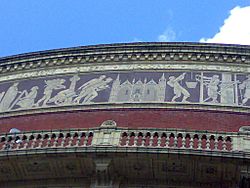
Peterborough enjoys a wide range of events including the annual East of England Show, Peterborough Festival and CAMRA beer festival, which takes place on the river embankment in late August.
The Key Theatre, built in 1973, is situated on the embankment, next to the River Nene. The theatre aims to provide entertainment, enlightenment and education by reflecting the rich culture Peterborough has to offer. The programme is made up of home-grown productions, national touring shows, local community productions and one-off concerts. There is disabled access, an infrared hearing system for the deaf and hard of hearing and there are also regular signed performances.
In 1937, the Odeon Cinema opened on Broadway, where it operated successfully for more than half a century. In 1991, the Odeon showed its last film to the public and was left to fall into a state of disrepair, until 1997, when a local entrepreneur purchased the building as part of a larger project, including a restaurant and art gallery. The Broadway, designed by Tim Foster Architects, was one of the largest theatres in the region and offered a selection of live entertainment, including music, comedy and films. In 2009, it was severely damaged by arsonists, resulting in closure when its insurers refused to pay the claim due to faulty fire detection systems. The Embassy Theatre, a large Art Deco building designed by David Evelyn Nye, also opened on Broadway in 1937. Nye was usually a cinema architect, and this was his only theatre. The Embassy was converted into a cinema in 1953, becoming the ABC and later the Cannon Cinema, before it was closed in 1989. Since 1996, the premises have been occupied by the Edwards bar chain.
The John Clare Theatre within the new central library, again on Broadway, is home to the Peterborough Film Society. One of the region's leading venues, the Cresset in Bretton, provides a wide range of events for the residents of the city and beyond, including theatre, comedy, music and dance. Peterborough has a 13-screen Showcase Cinema, an ice rink and two indoor swimming pools open to the general public. A diverse range of restaurants can be found throughout the city, including Chinese & Cantonese, Indian & Nepalese, Thai and many Italian restaurants. Peterborough has recently been used as the setting in popular literature: A Short History of Tractors in Ukrainian by Marina Lewycka, A Spot of Bother by Mark Haddon and, the first in a projected series, Long Way Home, a debut novel by Eva Doran.
Sport
Peterborough United Football Club, known as The Posh, has been the local football team since 1934. The ground is situated at London Road on the south bank of the River Nene. Peterborough United have a history of cup giant-killings. They set the record for the highest number of league goals (134, Terry Bly alone scoring 52) in the 1960-61 season, which was their first season in the Football League, in which they won the Fourth Division title. The club's highest finish position to date was tenth place in Division One, then the second tier of English football, in the 1992-93 season. Irish property developer Darragh MacAnthony was appointed chairman in 2006 and is now owner, having undertaken a lengthy purchase from Barry Fry who remains director of football, having also been manager of the club from 1996 to 2005. Peterborough also has two non-league football teams. Peterborough Northern Star FC, play at Chestnut Avenue, Dogsthorpe and compete in the United Counties League. Peterborough Sports FC play at Lincoln Road and compete one division below Peterborough Northern Star in the United Counties League.
As well as football, Peterborough has teams competing in rugby, cricket, hockey, ice hockey, rowing, athletics, American and Australian rules football. Although Cambridgeshire is not a first-class cricket county, Northamptonshire staged some home matches in the city between 1906 and 1974. Peterborough Town Cricket Club and the City of Peterborough Hockey Club compete at their shared ground in Westwood.
After reforming in 2005, rugby union club Peterborough Lions RFC now compete in National League 3 Midlands. Meanwhile, the city's oldest rugby team, Peterborough RUFC, play at Second Drove (otherwise known as "Fortress Fengate"), and have struggled in recent seasons. Relegation in 2013/14 season, from Midlands 1 East, has been followed by a season in the lower-mid table of the Midlands 2 East (South).
Peterborough City Rowing Club moved from its riverside setting to the current Thorpe Meadows location in 1983. The spring and summer regattas held there attract rowers and scullers from competing clubs all over the country. Every February the adjacent River Nene is host to the head of the river race, which again attracts hundreds of entries. Peterborough Athletic Club train and compete at the embankment athletics arena. In 2006, after 10 years, the Great Eastern Run returned to the racing calendar. Around 3,000 runners raced through the flat streets of Peterborough for the half-marathon, supported by thousands of spectators along the course.
Peterborough Phantoms are the city's ice hockey team, playing in the English Premier League at the East of England Ice Rink. Motorcycle speedway is also a popular sport in Peterborough, with race meetings held at the East of England Showground. The team, known as the Peterborough Panthers, have operated regularly in the Elite League. The Showground hosts the annual British Motorcycle Federation Rally each May. In 2009, Peterborough hosted one of the first rounds of the Tour Series, a new series of televised town and city centre cycling races. As of 2015[update], the city has hosted a round of the Tour Series each year since, with the exception of 2013.
In March 2017 the first bandy session in England for over a century will be held in Peterborough, in the form of rink bandy.
Media
There is a major radio transmitter at Morborne, approximately eight miles (13 km) west of Peterborough, for national FM radio (BBC Radios 1–4 and Classic FM) and BBC Radio Cambridgeshire. This facility includes a 154 metre (505 ft) high guyed radio mast which collapsed in 2004 after a fire and has since been re-built. Another transmission site at Gunthorpe in the north east of the city transmits AM/MW and local FM radio. The site is only 3 metres (10 ft) above sea level and has an 83 metre (270 ft) high active insulated guyed mast situated on it.
Peterborough is the largest city in the UK without any local radio of its own, although it is covered by four local radio stations and one regional station. Heart Cambridgeshire, the original independent local radio station launched as Hereward Radio in 1980 and becoming Heart Peterborough in 2009, still holds a large section of the market on 102.7 MHz but relocated to Cambridge in 2012, where it began sharing the localised programming (of mainly national output) with Heart Cambridge. Hereward's sister station, WGMS, was launched on the old 1332 kHz (225 meters) frequency in 1992; known as Classic Gold from 1994 to 2007, it is now part of Heart's sister Smooth Radio network, but has no programming made in Peterborough. Connect Radio (from 1999 to 2010, known as Lite FM), was the city's second commercial station on 106.8 MHz, but is now broadcast partly from Kettering and partly from Southend.
Radio Cambridgeshire, the BBC local radio station, began broadcasting in 1992 on 95.7 MHz (and, originally, 1449 kHz) in the north of the county; it maintains a studio in Priestgate, having moved from Broadway in 2012. Kiss 105-108 is the regional station for the East of England, broadcasting, since 2006, on 107.7 MHz in Peterborough. NOW Peterborough is the local DAB multiplex; BBC National DAB and the national commercial multiplex, Digital One, are also available in the city. Peterborough is in the Anglia Television transmission area for Independent Television, with a small studio in the city (although it borders ITV Central). This is broadcast with BBC One and Two (East), Channel 4 and Channel 5 from Sandy Heath. The digital switchover in the East of England took place in 2011. Shopping channel Ideal World is broadcast nationwide on Freeview from studios in Newark Road, Fengate.
The Peterborough Telegraph (established 1948) is the city's newspaper, published on Thursdays and, until 2012, six days a week as the Evening Telegraph, with jobs, property, motors and entertainment supplements. The Telegraph is now owned by East Midlands Newspapers, part of Johnston Press of Edinburgh. Its website, Peterborough Today, is updated six days a week. The PT's sister paper, the Peterborough Citizen (1898), is a weekly paper delivered free to many homes in the city. The Peterborough Herald and Post (1989, a replacement for the Peterborough Standard, established 1872) ceased publication in 2008. The publisher Emap, which specialises in the production of magazines and the organisation of business events and conferences, traces its origins back to Peterborough in 1854. The 33rd Mayor of Peterborough, Sir Richard Winfrey JP, founder of what would become the East Midland Allied Press, was perhaps the last person to read the Riot Act in 1914.
Peterborough has been used as a location for various television programmes and films. The 1982 BBC production of The Barchester Chronicles was filmed largely in and around Peterborough. In 1983 opening scenes for the 13th 007 film, Octopussy, starring Sir Roger Moore, were filmed at Orton Mere. A music video for the song BreakThru by the band Queen was also shot on the preserved Nene Valley Railway in 1989. In 1995 Pierce Brosnan filmed train crash sequences for the 17th James Bond film, GoldenEye, at the former sugar beet factory. A scene for the film The Da Vinci Code was filmed at Burghley House during five weeks secret filming in 2006; and actor, Lee Marvin, found himself camping in Ferry Meadows during the filming of The Dirty Dozen: Next Mission in 1985. In October 2008 Hollywood returned to Wansford for the filming of the musical Nine, starring Penélope Cruz and Daniel Day-Lewis.
Landmarks
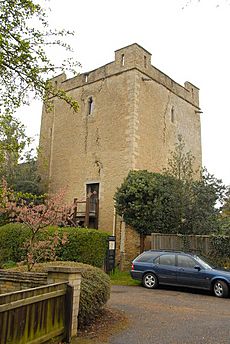
The Cathedral Church of Saint Peter, Saint Paul and Saint Andrew, whose statues look down from the three high gables of the West Front, was founded as a monastery in AD 655 and re-built in its present form between 1118 and 1238. It has been the seat of the Bishop of Peterborough since the diocese was created in 1541, when the last abbot was made the first bishop and the abbot's house was converted into the episcopal palace. Peterborough Cathedral is one of the most intact large Norman buildings in England and is renowned for its imposing early English Gothic West Front which, with its three enormous arches, is without architectural precedent and with no direct successor. The cathedral has the distinction of having had two queens buried beneath its paving: Katherine of Aragon and Mary, Queen of Scots. The remains of Queen Mary were removed to Westminster Abbey by her son James I when he became King of England.
The general layout of Peterborough is attributed to Martin de Vecti who, as abbot from 1133 to 1155, rebuilt the settlement on dry limestone to the west of the monastery, rather than the often-flooded marshlands to the east. Abbot Martin was responsible for laying out the market place and the wharf beside the river. Peterborough's 17th-century Guildhall was built in 1671 by John Lovin, who also restored the bishop's palace shortly after the restoration of King Charles II. It stands on columns, providing an open ground floor for the butter and poultry markets which used to be held there. The Market Place was renamed Cathedral Square and the adjacent Gates Memorial Fountain moved to Bishop's Road Gardens in 1963, when the (then weekly) market was transferred to the site of the old cattle market.
Peterscourt on City Road was designed by Sir George Gilbert Scott in 1864, housing St. Peter's Teacher Training College for men until 1938. The building is mainly listed for the 18th century doorway, brought from the London Guildhall following war damage. Nearby Tout Hill, the site of a castle bailey, is a scheduled monument. The city has a large Victorian park containing formal gardens, children's play areas, an aviary, bowling green, tennis courts, pitch and putt course and tea rooms. The park has been awarded the Green Flag Award, the national standard for parks and green spaces, by the Civic Trust. A Cross of Sacrifice was erected in Broadway cemetery by the Imperial War Graves Commission in the early 1920s. The Lido, a striking building with elements of art deco design, was opened in 1936 and is one of the few survivors of its type still in use.
Peterborough Museum and Art Gallery, built in 1816, housed the city's first infirmary from 1857 to 1928. The museum has a collection of some 227,000 objects, including local archaeology and social history, from the products of the Roman pottery industry to Britain's oldest known murder victim; a collection of marine fossil remains from the Jurassic period of international importance; the manuscripts of John Clare, the "Northamptonshire Peasant Poet" as he was commonly known in his own time; and the Norman Cross collection of items made by French prisoners of war. These prisoners were kept at Norman Cross on the outskirts of Peterborough from 1797 to 1814, in what is believed to be the world's first purpose built prisoner of war camp. The art collection contains an impressive variety of paintings, prints and drawings dating from the 1600s to the present day. Peterborough Museum also holds regular temporary exhibitions, weekend events and guided tours.
Burghley House to the north of Peterborough, near Stamford, was built and mostly designed by Sir William Cecil, later 1st Baron Burghley, who was Lord High Treasurer to Queen Elizabeth I for most of her reign. The country house, with a park laid out by Lancelot 'Capability' Brown in the 18th century, is one of the principal examples of 16th-century English architecture. The estate, still home to his descendants, hosts the Burghley Horse Trials, an annual three-day event. Another Grade I listed building, Milton Hall near Castor, ancestral home of the Barons and later Earls Fitzwilliam, also dates from the same period. For two centuries following the restoration the city was a pocket borough of this family.
The John Clare Cottage in the village of Helpston was purchased by the John Clare Trust in 2005. The cottage, home of John Clare from his birth in 1793 until 1832, has been restored using traditional building methods to create a resource where visitors can learn about the poet, his works and how rural people lived in the early 19th century. The John Clare Cottage and Thorney Heritage Museum form part of the Greater Fens Museum Partnership, along with Peterborough Museum and Flag Fen.
Longthorpe Tower, a 14th-century three-storey tower and fortified manor house in the care of English Heritage, is situated about 2 miles (3.2 km) west of the city centre. It is a scheduled monument, and contains the finest and most complete set of domestic paintings of their period in northern Europe. Nearby Thorpe Hall is one of the few mansions built in the Commonwealth period. A maternity hospital from 1943 to 1970, it was acquired by the Sue Ryder Foundation in 1986 and is currently in use as a hospice.
Flag Fen, the Bronze Age archaeological site, was discovered in 1982, when a team led by Dr Francis Pryor carried out a survey of dykes in the area. Probably religious, it comprises a large number of poles arranged in five long rows, connecting Whittlesey with Peterborough across the wet fenland. The museum exhibits many of the artefacts found, including what is believed to be the oldest wheel in Britain. An exposed section of the Roman road known as the Fen Causeway also crosses the site.
The Nene Valley Railway, which is now a 7.5-mile (12 km) heritage railway, was one of the last passenger lines to fall under the Beeching Axe in 1966, although it remained open for freight traffic until 1972. In 1974, the former development corporation bought the line, which runs from the city centre to Yarwell Junction just west of Wansford via Orton Mere and the 500 acre (202 ha) Ferry Meadows country park, and leased it to the Peterborough Railway Society. Railworld is a railway museum located beside Peterborough Nene Valley railway station.
The Nene Park, which opened in 1978, covers a site 3.5 miles (5.6 km) long, from slightly west of Castor to the centre of Peterborough. The park has three lakes, one of which houses a watersports centre. Ferry Meadows, one of the major destinations and attractions signposted on the Green Wheel, occupies a large portion of Nene Park. Orton Mere provides access to the east of the park.
Southey Wood, once included in the Royal Forest of Rockingham, is a mixed woodland maintained by the Forestry Commission between the villages of Upton and Ufford. Nearby, Castor Hanglands, Barnack Hills and Holes and Bedford Purlieus national nature reserves are each sites of special scientific interest. In 2002, the Hills and Holes, one of Natural England's 35 spotlight reserves, was designated a special area of conservation as part of the Natura 2000 network of sites throughout the European Union.
Geography
Climate
According to the Köppen classification the British Isles experience a maritime climate characterised by relatively cool summers and mild winters. Compared with other parts of the country, East Anglia is slightly warmer and sunnier in the summer and colder and frostier in the winter. Owing to its inland position, furthest from the landfall of most Atlantic depressions, Cambridgeshire is one of the driest counties in the UK, receiving, on average, around 600 mm (2 ft) of rain per year. The Met Office weather station at Wittering, within the unitary authority of Peterborough, recorded a maximum temperature of 35.3 °C (95.5 °F) on 1 July 2015. The lowest temperature in recent years was −13.4 °C (7.9 °F) during February 2012.
| Climate data for Wittering, elevation: 73m (1981-2010) (Weather station 9 miles W of Peterborough) | |||||||||||||
|---|---|---|---|---|---|---|---|---|---|---|---|---|---|
| Month | Jan | Feb | Mar | Apr | May | Jun | Jul | Aug | Sep | Oct | Nov | Dec | Year |
| Average high °C (°F) | 6.8 (44.2) |
7.2 (45.0) |
10.1 (50.2) |
12.6 (54.7) |
16.0 (60.8) |
19.0 (66.2) |
21.7 (71.1) |
21.5 (70.7) |
18.4 (65.1) |
14.1 (57.4) |
9.7 (49.5) |
6.9 (44.4) |
13.7 (56.7) |
| Daily mean °C (°F) | 4.0 (39.2) |
4.1 (39.4) |
6.4 (43.5) |
8.4 (47.1) |
11.6 (52.9) |
14.5 (58.1) |
16.9 (62.4) |
16.8 (62.2) |
14.3 (57.7) |
10.6 (51.1) |
6.8 (44.2) |
4.3 (39.7) |
9.9 (49.8) |
| Average low °C (°F) | 1.2 (34.2) |
0.9 (33.6) |
2.6 (36.7) |
4.2 (39.6) |
7.1 (44.8) |
10.0 (50.0) |
12.1 (53.8) |
12.1 (53.8) |
10.1 (50.2) |
7.1 (44.8) |
3.8 (38.8) |
1.6 (34.9) |
6.1 (43.0) |
| Average precipitation mm (inches) | 48.0 (1.89) |
36.8 (1.45) |
42.0 (1.65) |
49.6 (1.95) |
54.9 (2.16) |
52.0 (2.05) |
52.4 (2.06) |
55.8 (2.20) |
55.2 (2.17) |
59.3 (2.33) |
55.8 (2.20) |
47.2 (1.86) |
608.9 (23.97) |
| Average rainy days | 10.3 | 9.1 | 9.8 | 9.2 | 9.6 | 9.0 | 8.3 | 8.9 | 8.4 | 9.5 | 10.5 | 10.1 | 112.6 |
| Mean monthly sunshine hours | 63.8 | 82.9 | 113.1 | 156.4 | 196.5 | 191.6 | 204.3 | 192.3 | 146.8 | 115.5 | 73.8 | 58.9 | 1,596 |
| Source: Met Office | |||||||||||||
Topography
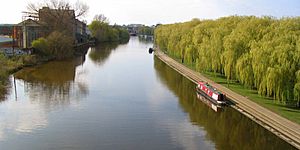
East Anglia is most notable for being almost flat. During the Ice Age much of the region was covered by ice sheets and this has influenced the topography and nature of the soils. Much of Cambridgeshire is low-lying, in some places below present-day mean sea level. The lowest point on land is supposedly just to the south of the city at Holme Fen, which is 2.75 metres (9 ft) below sea level. The largest of the many settlements along the Fen edge, Peterborough has been called the Gateway to the Fens. Before they were drained the Fens were liable to periodic flooding so arable farming was limited to the higher areas of the Fen edge, with the rest of the Fenland dedicated to pastoral farming. In this way, the mediaeval and early modern Fens stood in contrast to the rest of southern England, which was primarily arable. Since the advent of modern drainage in the nineteenth and twentieth centuries the Fens have been radically transformed such that arable farming has almost entirely replaced pastoral. The unitary authority extends north west to the settlements of Wothorpe and Wittering and east beyond Thorney into the Fens, and it includes the Ortons, south of the River Nene. It borders Northamptonshire to the west, Lincolnshire to the north, and the Cambridgeshire districts of Fenland and Huntingdonshire to the south and east. The city centre is located at 52°35'N latitude 0°15'W longitude or Ordnance Survey national grid reference TL 185 998.
Urban areas of the city
Townships are in bold type. In addition to the surrounding villages, Bretton, Orton Longueville and Orton Waterville are parished. The city council also works closely with Werrington neighbourhood association which operates on a similar basis to a parish council.
Bretton – Dogsthorpe – Eastfield – Eastgate – Fengate – Fletton – Gunthorpe – The Hamptons – Longthorpe – Millfield – Netherton – Newark – New England – The Ortons – Parnwell – Paston – Ravensthorpe – Stanground – Walton – Werrington – West Town – Westwood – Woodston
Surrounding villages in the district
Civil parishes do not cover the whole of England and mostly exist in rural hinterland. They are usually administered by parish councils which have various local responsibilities.
Ailsworth – Bainton – Barnack – Borough Fen – Castor – Deeping Gate – Etton – Eye – Eye Green – Glinton – Helpston – Marholm – Maxey – Newborough – Northborough – Peakirk – Southorpe – St. Martin's Without – Sutton – Thorney – Thornhaugh – Ufford – Upton – Wansford – Wittering – Wothorpe
These are further arranged into 24 electoral wards for the purposes of local government. 15 wards comprise the Peterborough constituency for elections to the House of Commons, while the remaining nine fall within the North West Cambridgeshire constituency.
Linguistics
Peterborough lies in the middle of several distinct regional accent groups and as such has a hybrid of Fenland East Anglian, East Midland and London Estuary English features. The city falls just north of the A vowel isogloss and as such most native speakers will use the flat A, as found in cat, in words such as last. Yod-dropping is often heard from Peterborians, as in the rest of East Anglia, for example new as. However, the large number of newcomers has impacted greatly on the English spoken by the younger generation. Common so-called Estuary English features such as L-vocalisation, T glottalisation and Th-fronting give today's Peterborough accent a definite south-eastern sound.
Affiliations
Town twinning started in Europe after the Second World War. Its purpose was to promote friendship and greater understanding between the people of different European cities. A twinning link is a formal, long-term friendship agreement involving co-operation between two communities in different countries and endorsed by both local authorities. The two communities organise projects and activities addressing a range of issues and develop an understanding of historical, cultural, lifestyle similarities and differences. Peterborough is twinned with the following municipalities:
 Alcalá de Henares, Spain (birthplace of Queen Katherine, 1986)
Alcalá de Henares, Spain (birthplace of Queen Katherine, 1986) Bourges, France (1957)
Bourges, France (1957) Forlì, Italy (1981)
Forlì, Italy (1981) Viersen, Germany (1981)
Viersen, Germany (1981) Vinnytsia, Ukraine (1991)
Vinnytsia, Ukraine (1991)
Bourges and Forlì are also twinned with each other. The city also has more informal friendship links with Foggia, Italy; Kwe Kwe, Zimbabwe; Pécs, Hungary; and all Peterboroughs around the world. The county of Cambridgeshire has been twinned with Kreis Viersen, Germany since 1983.
Economy
Regeneration
According to the City Council, Peterborough has a history of successful economic growth and continues to act as an attractor for investment and an engine of growth. Its ambition is to achieve sustainable growth that can be maintained without creating significant economic problems.
Figures plotting growth from 1995 to 2004, revealed that Peterborough had become the most successful economy among unitary authorities in the East of England. They also revealed that the city's economy had grown faster than the regional average and any other economy in the region. It has a strong economy in the environmental goods and services sector and has the largest cluster of environmental businesses in the UK.
In 1994, Peterborough designated itself one of four environment cities in the UK and began working to become the country's acknowledged environment capital. Peterborough Environment City Trust (PECT), an independent charity, was set up at the same time to work towards this goal, delivering projects promoting healthier and sustainable living in the city. Until 2017, PECT organised a yearly 'Green Festival' centered around Cathedral Square, Peterborough, which also benefited local artists and arts organisations through attracting Arts Council funding grants aided by arts facilitator organisation Metal. During the summer of 2018 the last Green Festival was held at Nene Park, in 2019 Peterborough's community environmental projects attracted ministerial attention from the then Environment Secretary Michael Gove. During the COVID-19 pandemic of 2020-21 Peterborough's culture and leisure umbrella charity, Vivacity ceased operating. This led to a restructuring of many of the arts organisations, they are now found under the heading City Culture Peterborough
The council and regional development agency have taken advice on regeneration issues from a number of internationally recognised experts, including Benjamin Barber (formerly an adviser to President Bill Clinton), Jan Gustav Strandenaes (United Nations adviser on environmental issues) and Patama Roorakwit (a Thai "community architect").
Employment
According to the 2001 census, the workplace population of 90,656 is divided into 60,118 people who live in Peterborough and 30,358 people who commute in. A further 13,161 residents commute out of the city to work. Earnings in Peterborough are lower than average. Median earnings for full-time workers were £11.93 per hour in 2014, less than the regional median for the East of England of £13.62 and the median hourly rate of £13.15 for Great Britain as a whole. As part of the government's M11 corridor, Peterborough is committed to creating 17,500 jobs with the population growing to 200,000 by 2020.
Future employment will also be created through the plan for the city centre launched by the council in 2003. Predictions of the levels and types of employment created were published in 2005. These include 1,421 jobs created in retail; 1,067 created in a variety of leisure and cultural developments; 338 in three hotels; and a further 4,847 jobs created in offices and other workspaces. Recent relocations of large employers include both Tesco (1,070 employees) and Debenhams (850 employees) distribution centres. A further 2,500 jobs were to be created in the £140 million Gateway warehouse and distribution park. This was expected to compensate for the 6,000 job losses as a result of the decline in manufacturing, anticipated in a report cited by the cabinet member for economic growth and regeneration in 2006.
With traditionally low levels of unemployment, Peterborough is a popular destination for workers and has seen significant growth through migration since the post-war period. The leader of the council said in August 2006 that he believed that 80% of the 65,000 people who had arrived in East Anglia from the states that joined the European Union in 2004 were living in Peterborough. To help cope with this influx, the council put forward plans to construct an average of 1,300 homes each year until 2021. Demand for short term employees remains high and the market supports up to 20 high street recruitment agencies at any given time. Peterborough Trades Council, formed in 1898, is affiliated to the Trades Union Congress.
Notable people
Peterborough is the birthplace of many notable people, the astronomer George Alcock, one of the most successful visual discoverers of novas and comets; John Clare, from Helpston, the nineteenth century poet; artist, Christopher Perkins – brother of Frank; and Sir Henry Royce, 1st Baronet of Seaton, engineer and co-founder of Rolls-Royce. Physician, actor and author, "Sir" John Hill, credited with 76 separate works in the Dictionary of National Biography, the most valuable of which dealing with botany, is also said to have been born here. The socialist writer and illustrator, Frank Horrabin, who was born in the city, and was elected as the Labour Member of Parliament in 1929.
The utilitarian philosopher, Dr Richard Cumberland, was 14th Lord Bishop of Peterborough from 1691 until his death in 1718; and Norfolk-born nurse and humanitarian, Edith Cavell, who received part of her education at Laurel Court in the Minster Precinct, is commemorated by a plaque in the cathedral and by the name of the hospital. A gravedigger called Old Scarlett, who's portrait can be seen above the west door of Peterborough Cathedral, is considered a folk hero. He died in 1594 at the age of 98, having spent much of his life as the sexton at Peterborough Cathedral; having buried two monarchs, he has also been suggested as the inspiration for the gravedigger in Shakespeare's Hamlet. Two prominent historical figures were born locally, Hereward the Wake, an outlaw who led resistance to the Norman Conquest and now lends his name to several places and businesses in the city; and St. John Payne, one of the group of prominent Catholics martyred between 1535 and 1679 and later designated the Forty Martyrs of England and Wales, who was beatified by Pope Leo XIII in 1886 and canonised with the other 39 by Pope Paul VI in 1970.
Musicians include Sir Thomas Armstrong, organist, conductor and former principal of the Royal Academy of Music; Andy Bell, lead vocalist of the electronic pop duo Erasure; Barrie Forgie, leader of the BBC Big Band; Don Lusher, trombonist and former professor of the Royal College of Music and the Royal Marines School of Music; Paul Nicholas, actor and singer; Maxim Reality and Gizz Butt of The Prodigy and Aston Merrygold of Brit Award-winning pop group JLS. Comedian Ernie Wise lived on Thorpe Avenue for many years, next door to Canadian baritone and actor Edmund Hockridge. Jimmy Savile also lived in the city in the early 1990s.
In the sporting world, former Tottenham Hotspur and England footballer, David Bentley, was born in the city, as was Louis Smith, who at the 2008 games became Great Britain's first gymnast to win an individual Olympic medal in a century. Chelsea Football player, currently on loan at Luton Town footballer Isaiah Brown, was born in Peterborough, before joining Leicester City and later West Bromwich Albion, becoming the second youngest player to play in the Premier League.
Images for kids
See also
 In Spanish: Peterborough para niños
In Spanish: Peterborough para niños


